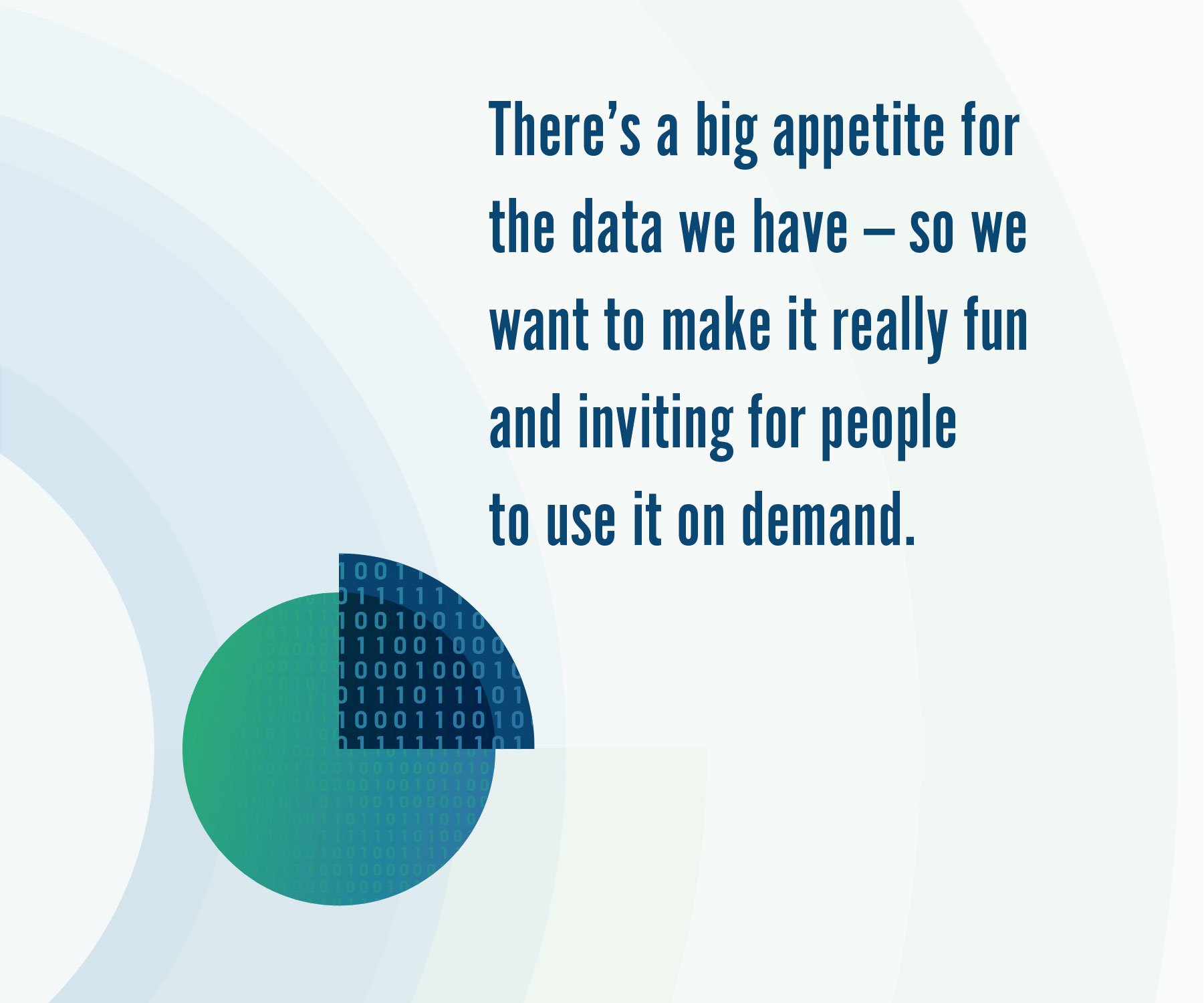edge:
Before you tell us about your current role, would you give us a quick overview of your background? How did you find your way to Sedgwick?
Adam:
I’m actually about two years into my second stint at Sedgwick. In between I spent about a decade in the NYC tech scene — working with startups, some fintech, some insurtech — gaining leadership experience with data product development and managing brand relationships. I also spent some time working in banking, specifically with credit card products.
edge:
How do things look different this time around?
Adam:
For starters, a lot bigger! During my first tenure with Sedgwick, almost 15 years ago now, I led a data team of about 10 to 20 people, and we were primarily focused on our largest clients. A lot is different today, but also, I’d say many things are comfortably the same. We’ve grown and expanded, but Sedgwick has stayed true to its core values and mission.
Our claims data is and has always been exceptionally well organized and of the highest quality; there’s just a lot more of it today. And it’s more varied as well, which is great to see — our auto data, for example, and newer lines like property and brand protection — but we’ve got awesome systems and technology in place so that, even with 10 times the data we had a decade ago, we have the resources we need. It’s a huge differentiator for Sedgwick that no matter what data we need to do our jobs well, we have it or we can get it.
edge:
What does being chief data officer of a data-heavy organization like Sedgwick entail?
Adam:
It’s a multifaceted job. Sedgwick handles claims for some of the biggest companies in the world, and with that there’s obviously a ton of data. We’re always getting reporting requests from clients, asking us to aggregate the data we collect on their behalf, and a big part of my responsibilities is overseeing our best practices in those areas.
With a data asset as large and concentrated as Sedgwick’s, another crucial component of my role is exploring how we take it to the next level and turn it into viable new services and products. I’d say I spend about 80% of my time focused on those forward-looking elements. Today our core offering is claims adjudication services, but what could it be tomorrow? Any number of things! I feel really lucky to get to spend my time thinking about that, knowing I’ve got a great team that’s able to uphold the day-to-day work and meet those demands.
edge:
When you’re in that forward-looking frame of mind, what do you see?
Adam:
When it comes to looking ahead for Sedgwick and how we might use data in the future, I’m thinking about what our clients stand to benefit. It’s taking all the components you’re reading and hearing about in the news today, like artificial intelligence (AI), and considering how those things will impact a data asset as big, and as historically relevant, as Sedgwick’s. I’m thinking about how we’ll apply modern technology to enhance the things we’re already doing and what new things we’ll come up with.
One example relates to the abundance of notes generated in the processing and adjudication of claims. We’re already paperless for correspondence, but future state may be the capability to take even more of the correspondence about claims (which we store as images) and turn them into actionable directions within the claims handling process, on behalf of our adjusters.
Other ideas involve the claims information we gather in connection with medical procedures. We’re working to make our data as objective as possible, like we’ve done with our attorney/firm scorecards. This could have a tremendous impact on how quickly, efficiently, and cost-effectively employers can get injured workers back to productivity.

edge:
What do you find clients are asking for when it comes to their data?
Adam:
For me, it’s exciting to hear our clients ask about how we’re expanding our data science capabilities and capitalizing on our ultra-modern technology environment. They want more visibility; they want to be able to tailor specific models for their projects — and we’re making that happen. Few, if any, tech providers have the level of holistic data we have; they’re using what they get from their clients, whereas we have this broad historical data set. And while others might not yet be able to fully operationalize that data, we’re already doing it. When you can combine intricate models with specific operational resources, you have a greater value proposition.
Ultimately, data needs to be scalable, and this is an important stepping stone toward homing in on the information people really want. Whereas now they might have to sift through entire reports to find the exact numbers they’re looking for, in the future I want us to be able to offer an interactive AI-enabled chat function or similar technology that can promptly reply to specific requests. That’s the kind of experience consumers have been conditioned to expect in their daily lives, and we want to automate a pipeline that would mimic that journey.
edge:
How do Sedgwick’s data services run the gamut for our full book of business?
Adam:
All clients really want the same thing from their data: to understand the bigger story it tells. A giant Excel file is only helpful if you can figure out what it means. Sedgwick helps our clients interpret that data. We’re packaging it in ways that are more easily digestible and intuitive and, therefore, more actionable.
Some time ago, massive retail programs were our only clients with dedicated data people. Now we’re able to invite all clients — big or small — on this journey. We want to meet our audience where they are, versus forcing them in a direction they don’t want or don’t know how to traverse.
Today, no matter the size of the organization, Sedgwick can offer a similar experience and set expectations of our data offering. Whether you’re a huge corporation or a more niche client, you can request data and reports and trust that what you’re getting back is consistently of the highest quality.
I want to be like the Starbucks of data. If you need someone to walk you through the most complex data, we have people for that. For the everyday loss run or report or state filing, we can do that too. We’re working to automate those types of requests so we can stay focused on the tailoring and custom analytics from our most talented data population. We’re really excited to pull that off.
edge:
How do Sedgwick’s self-service capabilities complement your team of analytical experts?
Adam:
You’ll hear Sedgwick talk a lot about having “data at your fingertips.” Our self-service capabilities are so robust that, in many ways, they give clients access to the same suite of tools they’d get working directly with our team.
There’s a big appetite for the data we have — so we want to make it really fun and inviting for people to use it on demand.
edge:
Bringing it full circle, since your first time at Sedgwick we’ve seen global growth — not just for our company but for our industry. Where have you seen the most expansion, and where do you anticipate even more?
Adam:
One of the biggest catalysts for globalization has been the introduction and widespread adoption of technologies like the cloud, which allow us to take advances we’re making in one location and deploy them throughout the world. When you look at global data transfer requirements from a compliance and a security standpoint, you want to make sure the data remains in the geography in which it originated. Cloud storage gives us the ability to do that. Sedgwick also benefits from having a relatively small number of enterprise systems — far fewer than you might expect for a growing company of our size and scope.
Bottom line: Great models need a lot of data. Sedgwick has that. But more than just quantity, we have a really productive and growing data science team that is using cutting-edge tools and algorithms to leverage that data. The next frontier will be deploying those models and tailoring them for our clients’ programs as specifically as we can.
To give you an idea of how important this is to Sedgwick, our data science team has grown by around 400% since 2020. And it’s more than just the people; we’ve also made a seven-figure investment in our data science platform.
There’s always room for improvement, and we are lucky to have clients that push us, but I would consider our data science capabilities on par with the best of the best — not just in our industry but in all of tech. We’re able to grow in this way and to work with some of the best experts in the field, in large part because of our unmatched data set. It’s a real game changer.
